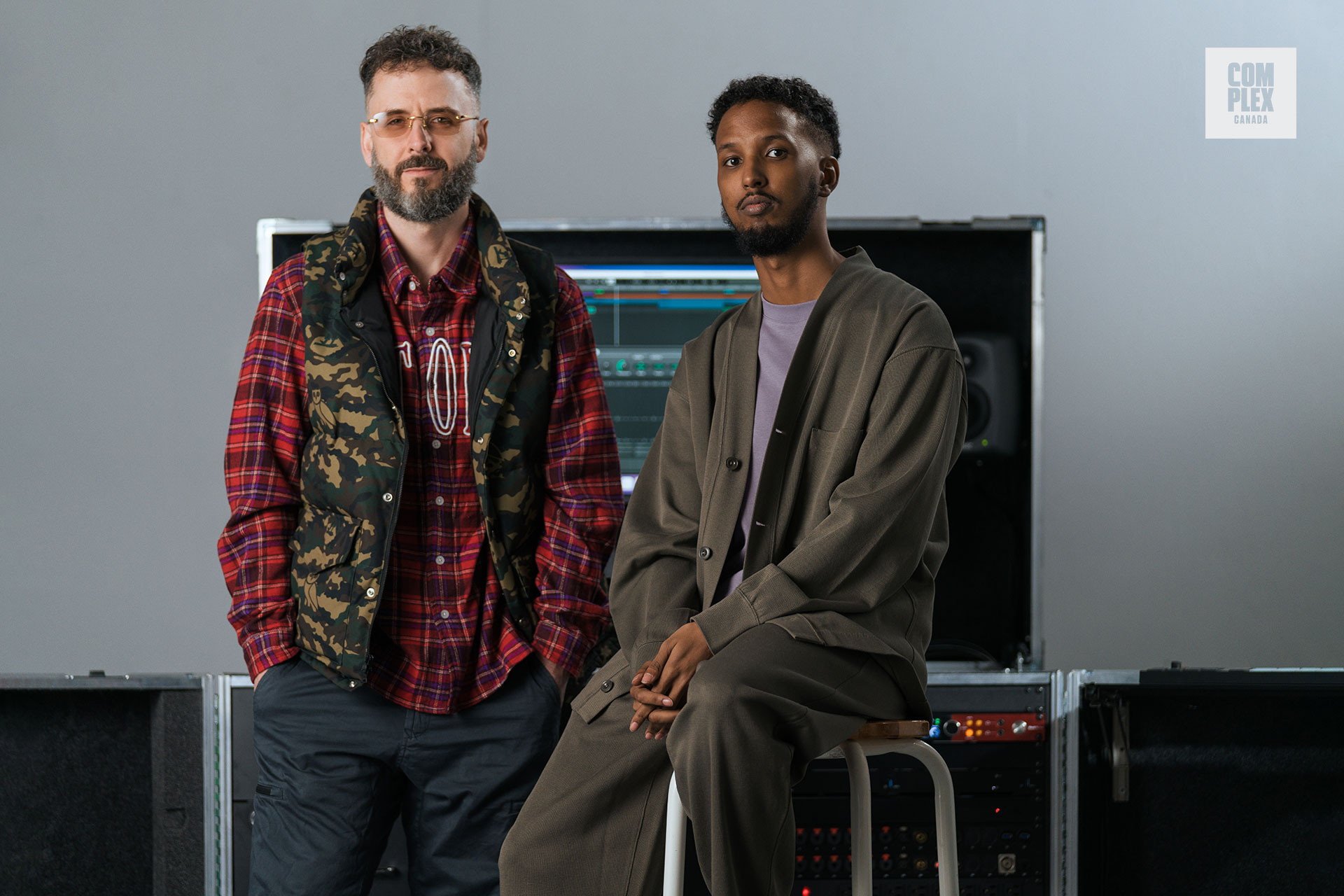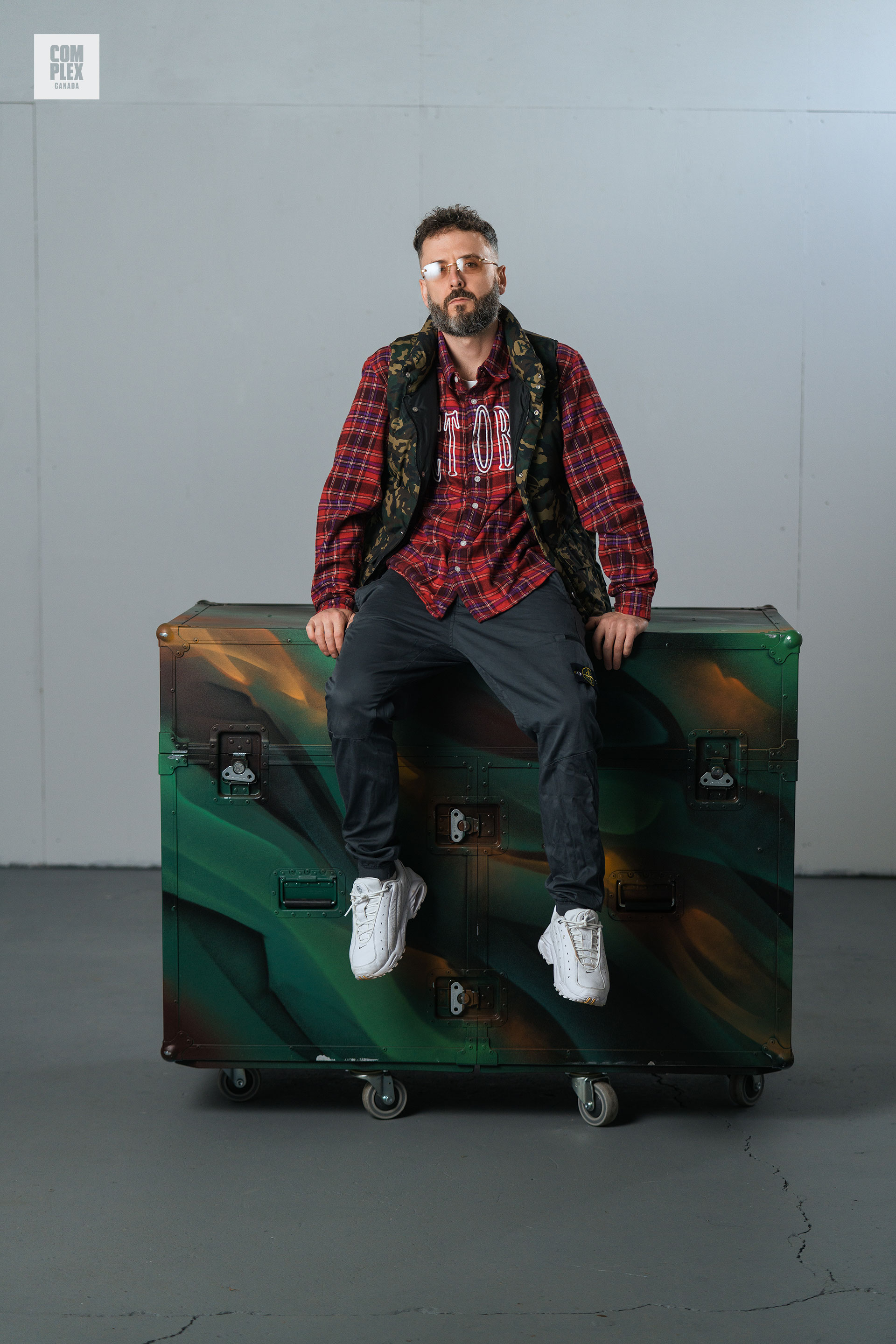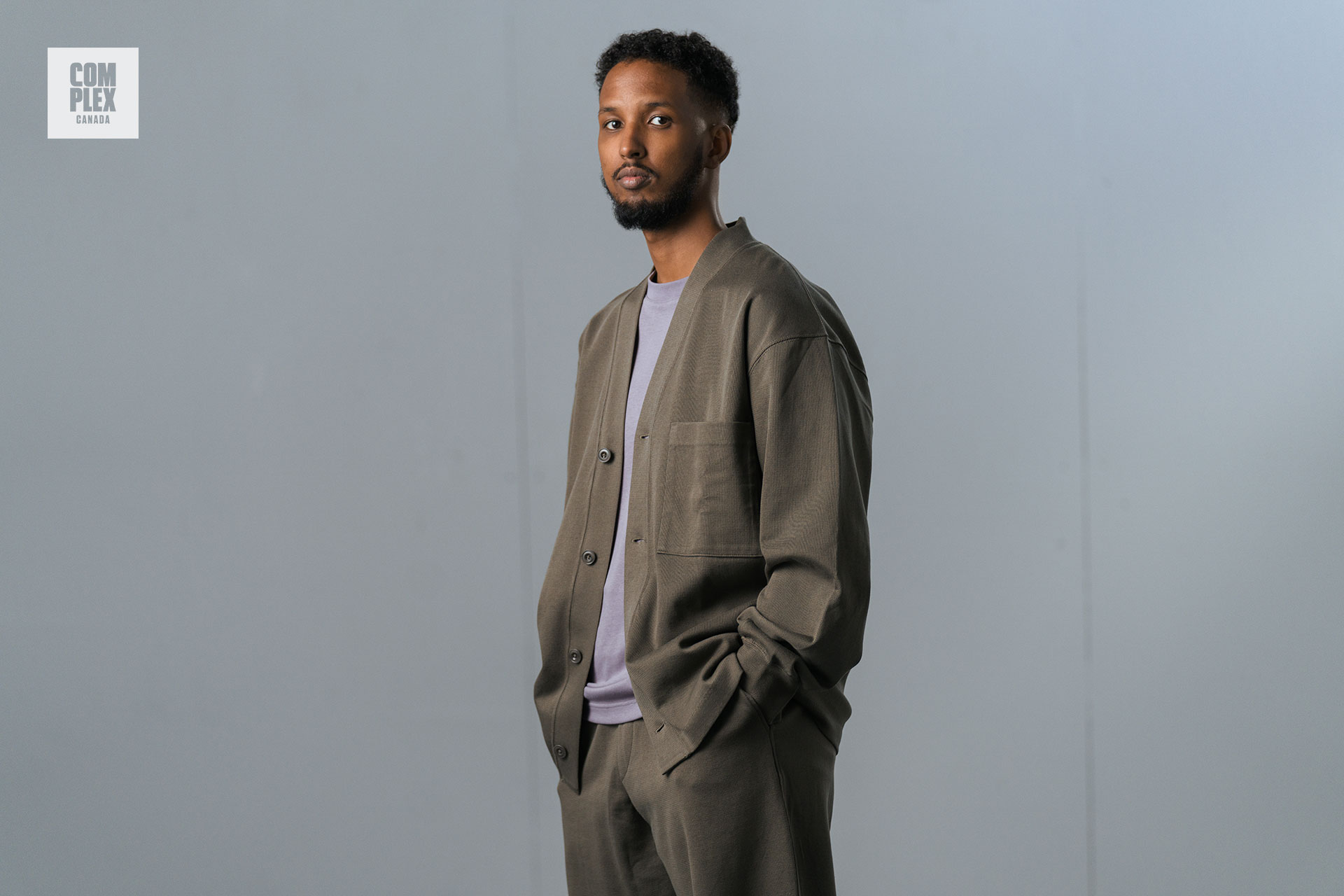

Last November, the Justice Fund parked an 18-wheeler in front of Toronto’s City Hall with a head-turning message plastered on its side: “‘Charitable’ Institutions in Canada are Hoarding $85,000,000,000.” That number is actually at $120 billion today. They aimed to bring attention to the philanthropic sector’s much-debated ‘disbursement quota’—the minimum amount registered charities are required to grant annually to causes, which sat at a paltry 3.5 percent. It appears decision-makers paid attention; the latest federal budget proposed raising that quota to 5 percent.
While 40 and Hassan are encouraged by the change, they say the work is still incomplete. In the conversation below, edited and condensed for clarity, they talk about Toronto’s gun violence problem, what they’re doing (and what Canada’s government isn’t) to address it, and how 40 aims to connect the city’s youth via his new mobile studio cases.
I think a lot of people don’t know about the Justice Fund yet. So maybe you can each talk about your individual backgrounds and experiences in the city. 40, obviously people know you for your music, but what spurred your passion to do this sort of work for social change?
40: I think gun violence specifically has touched probably everybody in the entire city in some proximity. It’s definitely touched me pretty closely, as it has my entire life. It’s tough to ration why people do the things they do when you’re coming from my sort of privileged position. So what I’m trying to do is create the narrative that a lot of people in this city who are suffering from those things are good people, and they don’t usually get the help and assistance because the programming isn’t set up in their direction.
It’s just about staying active in the community. Making music is my passion, my dream come true. I love what I do with Drake, of course, but I [value] really being on the ground and spend time and energy in this space, which is the future. You only need to go to one funeral—never mind two or three or more—and hear family members speak about why we’re burying their children to understand how important this work is. So that’s something that’s really close to my heart, my own experiences. And it’s what I’m trying to spend my time on moving forward.
Hassan: So, like Noah, I am a community guy. Nobody really knows about me because I prefer to do my work behind the scenes. I’ve been in the not-for-profit sector my whole life, as a fundraiser, both within Canada and abroad; my background is in international development. Here in Toronto, I’ve supported organizations on boards and committees, including Social Planning Toronto and FoodShare Toronto. I’m around, I do a lot of stuff.
Back in 2018, when Toronto had that weekend when both Smoke Dawg and Koba Prime were murdered, you wrote a post criticizing that the narrative around the shooting as being “reductive and kind of disconcerting,” right? What’s wrong with the current narrative around gun violence in Toronto?
40: First of all, it’s trauma porn. Whether it’s Instagram accounts or it’s 24-hour news cycles, they’re all engaging in that. It’s clickbait, essentially, and it’s pretty disgusting and revolting, and it adds to a cycle that’s really harmful for the community. Obviously, our major newspapers have all shown their true colours with their headlines, which are disgusting and completely inconsiderate of family, feelings, and mourning. The media in this city, across the board, should take a look in the mirror and realize they all have a responsibility and should be doing a better job, for one. And as people living in the city, I think we’re being desensitized to these matters. Just the fact that we’re not making that very simple connection from our hearts, and emotions, and empathy towards people in our own communities and our own city, that’s a problem.
Hassan: We’re continuously being told to be more resilient. Fuck your resiliency. Let’s figure out a way to solve these issues at their core. The city of Toronto just implemented their SafeTO plan. It’s well researched, full community consultations, yet only $1.4 million is associated with that program. You need to address these issues in financial resources or else everything else is just talk.
“I think gun violence specifically has touched probably everybody in the entire city in some proximity. It’s definitely touched me pretty closely, as it has my entire life.” – 40
I’m from Rexdale and I grew up around a lot of kids who had so much potential but reached dead ends or wound up incarcerated or wound up dead. That’s why what you’re doing feels so important to me. But that’s just a common theme you hear around the city, you know? So I’m wondering, how has gun violence in the city impacted you guys personally?
40: For myself, I’ve lost incredibly close friends, some of my closest friends, to gun violence. Those were very painful experiences, and it’s hard to turn back from that, right? So all I can do to move forward, really, is have a positive impact and hope I can contribute to slowing that violence, on any level. That’s just really where I want to put my energy as a human being. Because I’ve been in incredibly close proximity to those situations, and it’s not anything anybody wants to go through. There’s nothing to glorify. It’s horrific and it’s really painful. And this is probably part of my healing as well.
I’m in an industry within pop culture that can be interesting. Like, we all love a hard-ass record, right? So it’s a balance for me; I have to juggle on both sides. And so, this is a way to contribute in a positive manner, that I need for my own healing experience.
Hassan: So 2005 is when we declared the “Summer of the Gun” in the city of Toronto. Not much has changed since then. And if I’m being brutally honest, I am extremely desensitized to violence in the city of Toronto. It does not affect me in the way that it should. And that’s because we’ve gone decades without significant change in the city of Toronto. It says a lot when young people in Toronto know that when it gets warm in the city, that’s when the shots are fired.

“There are no bad kids. Everybody is good if offered a reasonable opportunity to show that they are good—and most of these youth have not had that opportunity.” – 40
Totally. It’s fucked up that that’s a thing.
Yonis: Right? It says a lot about our psyche as a city, and how we’re raising young people to deal with trauma and violence when it’s there on a recurring basis. When you’re seeing the age of the victims get younger and younger, and the perpetrators get younger and younger, that is a failing of our society collectively. And often a lot of people try to point to music for violence in the city. For me, music is a creative outlet for a lot of things. When you really try to analyze where the trauma comes from, it’s because Toronto is a city that is socially, politically, economically segregated. It’s not a coincidence that you have pockets in the city where violence only occurs, and those are the same neighborhoods that have over 50 percent child poverty rates.
40: And these are things people don’t know, right? I grew up downtown, so that’s my experience. But what I learned from people like Jelleestone, who’s a rapper from Rexdale that I spent a lot of time working with and one of my closest friends—like, I’ll never forget when I was 19 years old and he was like, “Yo, 40, there’s kids in the hood that have never seen downtown. They’ve never seen Toronto. 18-year-old kids who have never seen the city.” I was like, “What?” That was shocking information to learn for me. And I don’t think that’s changed.
One-hundred percent. For some kids there, downtown Toronto feels like it’s in a different country. It’s like you guys say on your website: “There are two versions of Toronto.” There’s a utopian version that’s filled with opportunity, and a bleak version plagued by violence and inequality. Let’s talk about where the government is failing in addressing these issues. What’s wrong with the solutions they’re proposing?
40: Yo listen, don’t let Yonis start rattling numbers to you. They are depressing and shocking, and your first reaction is going to be, “Nah, that can’t be true.”
Hassan: We should talk about the role of government within our society. For me, governments are supposed to be providing opportunities for communities to live in dignity and thrive. We are not seeing that. So then, on the flip side, what is the role of philanthropy? Philanthropy’s supposed to be filling those gaps for governments and address innovation, take risks and put trust in communities’ hands. We’re not seeing that.
Within Canada, when we first launched, there was about $85 billion of charitable assets in this country, money that’s already been tax credited. As of today, it’s $120 billion. A lot of that money is in the hands of less than 10,000 foundations in this country. About 6,000 of them are private foundations, making decisions, utilizing taxpayer money, and often Black and Indigenous charities don’t get that. Less than one percent of charitable giving goes to Black charities. Less than one percent goes to Indigenous charities.
40: Less than one percent! Can we just stop and take that in for a second? $120 billion in Canada has been earmarked for philanthropy and given the tax credits and it’s sitting there. That has to be a lie! That can’t be true. That’s enough money to fix all kinds of problems—boil water advisories, all sorts of food shortage issues, housing. Yonis, that cannot possibly be true. We’re Canada. We’re wonderful, kind people. How on earth would we do something like that?
“It’s not a coincidence that you have pockets in the city where violence only occurs, and those are the same neighborhoods that have over 50 percent child poverty rates.” – Yonis Hassan
Jesus. These private foundations are hoarding charity money like toilet paper.
Hassan: It makes no sense. Make it make sense.
40: It’s tough to make philanthropy make sense, right? Philanthropy is attached to capitalism. It’s all a vicious cycle. How are we going to get to a solution if we’re raising all this money and tax crediting all this money and it doesn’t get put to use? And when it does, less than one percent goes to Black organizations, and like 0.7 percent goes to Indigenous organizations?
Hassan: This is the one that messes everybody up.
40: We’re in an active genocide and we can only give 0.7 percent? Like, it’s nuts. So Canadians need to look closely in the mirror and realize who and what we are as a country—and take some responsibility for the fact that we don’t do the greatest job at serving our own community, you know?
Hassan: Last year, we took a truck that said “Canadian philanthropies are hoarding $85 billion of philanthropic assets” and we parked it right outside of City Hall. To this day, I’m still cleaning up my inbox from some in the philanthropic community of Canada—you know, insults, threats, name calling—all because we’re raising awareness about the fact that this money exists and it’s often in the hands of older white men who are privileged and are so disconnected from the communities that they claim to be serving.

Yeah, I saw that truck campaign outside City Hall. I know one of the changes you’ve been asking for is to increase the disbursement quota—the minimum amount registered charities have to spend on charitable initiatives—from 3.5 percent to 10 percent. Well, recently, the last federal budget proposed raising the quota to 5 percent, right?
Hassan: It’s well short of our objectives, but it increased nonetheless, which is pretty significant. You know, it was a very intense year of campaigning. And what this really means is come January 1st of next year, an additional over $900 million will be released for charities across Canada. So that small little change from 3.5 percent to 5 percent has released over $900 million.
Wow. That’s crazy! So then, how does it feel to see all that campaigning make an impact?
Hassan: Incomplete. Like, we were calling for a comprehensive philanthropic sector change, right? Not only because charities in this country can no longer afford to wait, but, at our core we’re an anti-violence organization, and the best way to address violence in the city of Toronto is making investments in affordable housing, transit, and food security. Will this go a long way? Absolutely. But it feels incomplete that we’ve left other opportunities on the table…. Direction and control is still in the hands of a lot of philanthropists and foundation executives, the majority of which are white and not reflective of the communities they serve. So, will they prioritize investing in Indigenous sovereignty? Will they prioritize in investing in land defenders and in anti-Black racism work? I’m not so sure.
Imagine if that quota was raised to 10 percent…
40: We’re talking about billions of dollars being released into the space. So we’re trying to bring awareness to issues that I’m almost positive over 90 percent of the country has no idea about—and should be upset about, if we’re trying to actually help our people and our communities.
“Drake does a lot of community work in this city that he is not in front of; nobody knows where he’s giving money or what he’s done—and that’s the way he likes it. – 40
I know the Justice Fund is aimed at helping communities in conflict with the law, and it’s anchored in the belief that teaching youth life skills and giving them socioeconomic opportunities can change things for them—
40: And it’s also anchored in the belief that those communities often don’t receive the help. When someone is going to give out money, they’re like, “Well, I don’t want to give money to a bad kid. I’m going to give money to a good kid.” And it’s like, well, who the hell do you think needs the help? The bad kid is the one who needs the help. And first of all, there are no bad kids. Everybody is good if offered a reasonable opportunity to show that they are good—and most of these youth have not had that opportunity. And so we’re now labeling them as bad, and forcing them into a corner where they don’t get the resources—and we’re sitting over here feeling so great about these resources we built, and we’re not even serving the community that needs it. It’s nuts. Sorry to cut you off.

No, no no, you’re absolutely right. But I wanted to ask, like, you guys have been holding these camps where you teach kids everything from music production to archery, to help give them a sense of worth. And 40, I know you have these mobile studios you’ve been working on. Tell me about those and what your aim is with creating them.
40: One day I stopped by Masaryk-Cown—an old community centre which had a studio I used to work at—and I spoke to one of the program directors, and was like, “Look, I want to build a studio in the community centre. Where is it?” And they’re just like, “Oh, it’s been gone for years. We just don’t have any space; all our rooms are full.” I was like, “I’ll drop 20 grand right now and build you a studio,” and they’re like, nah. I was so stunned. One of the big problems about studios in community centres is things get damaged, things get unplugged, stuff gets stolen, stuff gets broken.
And so it hit me after I built my first mobile studio case (MSC) to take on the Aubrey & the Three Migos Tour. Bad Bunny saw my case, and I’m there with him and his manager, and I’m fixing up some vocals and edits for him before we go out on stage. Bunny suddenly starts cursing in Spanish at Noah, his manager. I’m sitting there, like, “Yo Noah, is everything good? Everything I’m doing is OK, right?” He’s like, “No, everything’s perfect.” And then we walk away and I’m like, “Noah, what was that?” He’s like, “Oh, [Bunny] was just really angry—he was asking me, ‘Where do I get that studio? And how come I don’t have one? What is this? This thing’s incredible. I need one.’” And at that moment, I was like, ‘Oh, these things are pretty cool, aren’t they?’
[Laughs.] Amazing.
And so I toured 100 cities with it, and when we got back, the thing was still functioning perfectly. Nothing had fallen out, no cable was missing, everything was there. It all folds up into a box, you can put a lock on it. It shuts, done. You can’t steal nothing. You can’t break nothing. I’m like, ‘Man, if I can ship this thing around the world in boats, trucks, and planes, it can definitely handle a community centre.’
So now that evolves into Suzanna, my sister, helping with the programming and the assets inside the case, all the tools from financial literacy to support of all different kinds for youth who probably haven’t seen that type of information in school…. And the case is top of the line. It’s the same equipment I use in my studio facility, the same equipment I make records with, produce records with, mix records with—the same speakers, the same software, the same hardware, everything.
That’s so dope. Sounds legit. And so what’s the next step with these MSCs? How will you get kids involved with them?
40: My next ambition is to build enough of them and distribute them across the city so that every community centre, every community has one. Now you’ve got some synergy between the youth. They all have something in common. Maybe this guy from this neighborhood can go help over here in that neighborhood because something broke, but they all know how to use it. Also, you can interconnect the studios’ audio, so they can be sharing things with each other. A vocal can be laid from this community centre directly to this community centre, case to case, at a distance. You know, obviously traveling between certain communities can be problematic. This is a way they can have a connection without physically having to share a space and put their own safety at jeopardy.
I’m sure a lot of people are wondering this: What does The Boy think about the Justice Fund? What are Drake’s thoughts on what you guys are doing? Will he be getting involved?
40: I mean, look, I’ll just answer that and say Drake’s one of my best friends, my business partner, and he proudly supports me and all of my endeavors in this space…. You know, Drake does a lot of community work in this city that he is not in front of; nobody knows where he’s giving money or what he’s done—and that’s the way he likes it. I’m very proud of him for operating that way within the city. People can be critical of him, but that’s fine. They don’t know what we’re trying to do, or what he’s trying to do. And I support him by making quiet moves, and he’s going to support me in the work that we’re doing. He’s been vocal about that already. And as this moves forward and takes shape of what exactly it’s going to be, you’ll see him standing there with me to support us on this journey.
